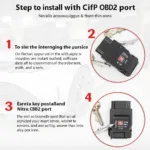Understanding your Volvo V50’s OBD2 codes is crucial for maintaining its performance and longevity. Whether you’re a seasoned mechanic or a DIY enthusiast, this guide will equip you with the knowledge you need to diagnose and address those pesky trouble codes. We’ll delve into common Volvo V50 OBD2 codes, their meanings, and potential solutions, empowering you to take control of your car’s health.
Decoding the Secrets of Your Volvo V50’s OBD2 Port
The OBD2 port, a standardized diagnostic interface, acts as a window into your Volvo V50’s electronic control unit (ECU). It provides access to a wealth of information about the vehicle’s systems, including the engine, transmission, and emissions control. When a problem arises, the ECU generates a specific OBD2 code, stored within the system’s memory, waiting to be retrieved by an OBD2 scanner. These codes are formatted as a combination of a letter and four numbers (e.g., P0171). The letter indicates the system affected (P for Powertrain, B for Body, C for Chassis, U for Network), while the numbers specify the particular fault.
By understanding these codes, you can pinpoint the root cause of an issue and avoid unnecessary guesswork and costly repairs. Volvo V50 OBD2 codes can range from simple sensor malfunctions to more complex issues within the engine or transmission.
Common Volvo V50 OBD2 Codes and Their Meanings
Some common Volvo V50 OBD2 codes include:
- P0171 (System Too Lean (Bank 1)): This indicates that the air-fuel mixture is too lean, meaning there is too much air and not enough fuel.
- P0420 (Catalyst System Efficiency Below Threshold (Bank 1)): This suggests a problem with the catalytic converter, which is responsible for reducing harmful emissions.
- P0014 (Camshaft Position “B” – Timing Over-Advanced or System Performance (Bank 1)): This points to an issue with the camshaft position sensor or the timing chain/belt.
- P0134 (O2 Sensor Circuit No Activity Detected (Bank 1 Sensor 1)): This indicates a problem with the oxygen sensor, which monitors the exhaust gases.
Each code provides a valuable clue, helping you narrow down the potential causes of the problem.
Troubleshooting Volvo V50 OBD2 Codes
Once you’ve retrieved the codes using an OBD2 scanner, the next step is to interpret their meaning and determine the appropriate course of action. While a comprehensive understanding of automotive systems is beneficial, numerous online resources and repair manuals can assist in diagnosing and resolving the identified issues. Consulting a qualified mechanic is always recommended for complex problems.
What if I have multiple Volvo V50 OBD2 codes?
Multiple codes can sometimes be interconnected. For example, a faulty oxygen sensor might trigger a lean condition code. Addressing the root cause (the faulty sensor) can often resolve multiple related codes.
Can I clear Volvo V50 OBD2 codes myself?
Yes, you can clear the codes using an OBD2 scanner. However, simply clearing the codes won’t fix the underlying problem. If the issue persists, the codes will reappear.
Diagnosing P0171: A Deeper Dive into a Common Volvo V50 OBD2 Code
The P0171 code is a frequently encountered issue in Volvo V50s. Potential causes include vacuum leaks, a malfunctioning mass airflow sensor (MAF), or a faulty fuel injector. Identifying the specific cause requires a systematic approach, often involving checking for vacuum leaks using a smoke test, inspecting the MAF sensor for contamination, and testing the fuel injectors.
Conclusion: Mastering Volvo V50 OBD2 Codes for Optimal Performance
Understanding and addressing Volvo V50 OBD2 codes is essential for maintaining your car’s health and performance. Armed with the knowledge provided in this guide and a reliable OBD2 scanner, you can take proactive steps to identify and resolve issues, saving time and money in the long run. Remember, regular maintenance and prompt attention to warning signs are crucial for preventing future problems and ensuring your Volvo V50 continues to run smoothly.
FAQ
- What is an OBD2 scanner? An OBD2 scanner is a device used to retrieve diagnostic trouble codes from a vehicle’s ECU.
- Where is the OBD2 port located in a Volvo V50? It’s typically located under the dashboard on the driver’s side.
- What does the P0420 code mean? It indicates a potential problem with the catalytic converter.
- Can I drive my Volvo V50 with an OBD2 code? It depends on the code. Some codes indicate minor issues, while others may signal serious problems that require immediate attention.
- How much does an OBD2 scanner cost? Prices vary depending on features and functionality, but affordable options are readily available.
- What should I do if I can’t figure out what a code means? Consult a qualified mechanic or refer to online resources and repair manuals.
- How often should I check my Volvo V50 for OBD2 codes? Regularly, especially if you notice any unusual performance issues.
Need Support? Contact us via WhatsApp: +1(641)206-8880, Email: [email protected] or visit us at 789 Elm Street, San Francisco, CA 94102, USA. Our customer support team is available 24/7.


